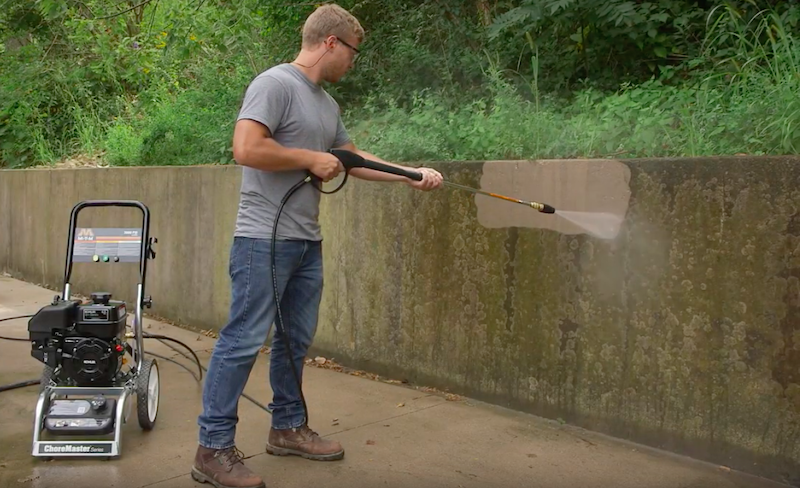
Power washing can feel like magic — watching years of grime vanish in seconds is deeply satisfying. But just because your pressure washer can blast away dirt doesn’t mean it’s safe for every surface.
So, is power washing safe for all outdoor surfaces?
No — not all surfaces can handle the pressure. Some materials can be damaged, etched, or even destroyed by incorrect power washing techniques. The key is knowing which surfaces are safe, which require caution, and when you should call a professional. 🧽⚠️
Let’s break it down by surface type so you can clean smart and avoid costly mistakes.
💥 What Makes Power Washing Potentially Unsafe?
A pressure washer can spray water at 1,500–4,000 PSI — that’s strong enough to cut through skin, strip paint, and gouge wood.
What can go wrong?
- Surface etching or cracking
- Water intrusion behind siding or windows
- Destroyed caulking, paint, or grout
- Damage to delicate materials like wood, stucco, or asphalt shingles
Safe power washing comes down to:
- The material you’re cleaning
- The pressure setting used
- The nozzle angle and distance
- Whether or not you’re using detergents or soft washing
✅ Surfaces That Are Generally Safe to Power Wash
These can typically handle moderate to high pressure:
1. Concrete and Asphalt Driveways
- Use a surface cleaner for even cleaning
- Avoid holding the wand too close to avoid streaking
2. Brick and Stone Patios
- Use a wide fan nozzle
- Be careful around mortar joints which can erode
3. Metal Fences and Gates
- Durable and easy to clean
- Avoid overly concentrated spray on rust-prone areas
4. Vinyl Siding (Soft Washed)
- Use low pressure with detergent
- Rinse thoroughly to avoid residue
5. Composite Decking
- Can tolerate gentle pressure
- Soft washing is best for removing mildew or algae
🌟 Pro Tip: Always start with the lowest effective pressure and work your way up if needed.
⚠️ Surfaces You Must Power Wash With Caution
These materials can be safely cleaned only with the right techniques:
1. Wood Decks and Fences
- Use a 25° or 40° nozzle
- Keep pressure under 1,500 PSI
- Too much pressure can splinter the wood 🌲
2. Stucco and Dryvit
- Very delicate
- Use soft washing only
- Too much water can crack or crumble the surface
3. Fiber Cement Siding (e.g., Hardie Board)
- Low-pressure wash with detergent
- Avoid pointing upward — water can seep behind the boards
4. Painted Surfaces
- Pressure can strip or flake paint
- Use low PSI and a gentle angle
- Avoid power washing if you plan to repaint soon — use soft wash instead 🎨
🚫 Surfaces You Should NOT Power Wash
Some materials are simply too fragile or porous and should be avoided:
❌ Asphalt Shingles (Roofs)
- High pressure can rip shingles, break seals, or void warranties
- Use soft washing with biodegradable roof cleaner instead 🏠
❌ Windows and Window Screens
- Glass can crack or shatter
- Screens will tear or stretch under pressure
- Always clean with a soft cloth or garden hose 🚿
❌ Old Mortar or Crumbling Brick
- Mortar can be blown out by pressure
- Instead, use low-pressure rinse and gentle brushing 🧱
❌ Outdoor Light Fixtures and Electrical Boxes
- Risk of electrical shock or damage
- Avoid direct spray — wipe these by hand or cover during cleaning
🧪 Soft Washing vs. Power Washing
| Soft Washing | Power Washing |
|---|---|
| Uses low pressure (under 500 PSI) | High pressure (1,500–4,000+ PSI) |
| Requires cleaning agents | May use just water |
| Ideal for delicate surfaces | Ideal for tough buildup |
| Reduces risk of damage | Risky on fragile materials |
If a surface can’t take pressure — soft washing is your best bet. 🧼💡
🧰 Nozzle and PSI Guidelines
| Surface | Recommended PSI | Nozzle Tip |
|---|---|---|
| Concrete/Brick | 2,500–3,000 PSI | 15° or 25° |
| Vinyl Siding | 1,300–1,600 PSI | 25° or 40° |
| Wood Deck | 500–1,200 PSI | 40° |
| Roof Shingles | Use soft wash only | Wide spray |
| Painted Surface | Under 1,000 PSI | 40° |
Always test a small area before going full blast. 👀
🌿 Environmental and Structural Considerations
- Don’t let runoff enter storm drains — use eco-safe detergents
- Avoid high-pressure near caulking, seams, or vents
- Keep distance from plants, landscaping, and animals 🐾
🧠 Final Tips for Safe Power Washing
- Start 2–3 feet away from the surface
- Never aim the wand directly at people or pets
- Use the correct nozzle and pressure for each task
- Watch for signs of surface wear or soft spots
- Read your power washer’s manual or hire a pro if unsure
🏁 Final Thoughts
Power washing is incredibly effective — but only if you know what you’re doing. While it’s safe for many outdoor surfaces like concrete, metal, and vinyl, it can seriously damage wood, stucco, shingles, and painted areas when used incorrectly. 💧🚫
When in doubt, use low pressure or soft washing techniques, and if you’re ever unsure — get help from a professional. A little care now can save you thousands in repairs later.
Browse Amazon Here For Top Rated Power Washers And Accessories






